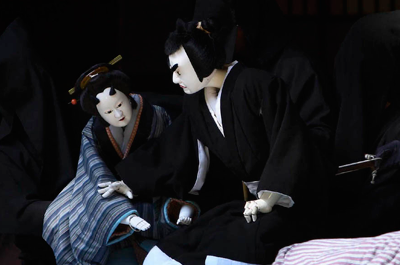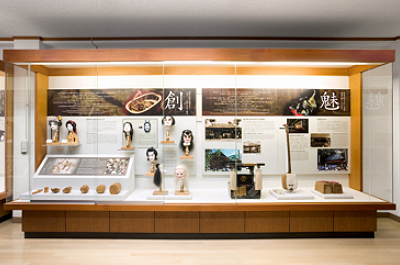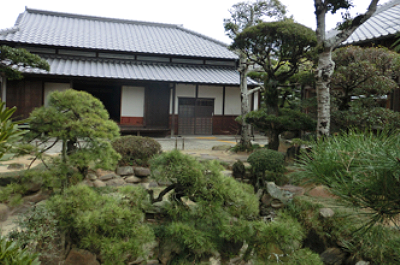1.Performances of Awa Ningyo Joruri
In Tokushima, jidai-mono, a historical drama, has been more popular and performed more frequently than sewa-mono, a drama based on incidents happened in the domestic life of common people in the Edo period, such as a love suicide.
Keisei Awa no Naruto is a collaboration work of five scenario writers including Hanji Chikamatsu, written based on a historical event in Awa (old name for Tokushima). This joruri (dramatic recitation accompanied by shamisen) depicts a family trouble of a feudal lord in Awa-han (Tokushima clan) in the Edo period.
This is the most frequently performed puppet play in Tokushima because love of mother and daughter is described realistically and the characters are people of Tokushima.
The following “acts” are especially popular in Keisei Awa no Naruto.
Junrei Uta no Dan (Act of the Pilgrim Song)
Jurobe and his wife Oyumi are living in Tamatsukuri, Osaka, under false names, disguising themselves as a robber, to recover a stolen treasure sword of his master in Awa-han. Their daughter Otsuru, separated from her parents when she was little, became a pilgrim leaving Awa to desperately search for her parents and happens to visit her parents’ house without knowing it.
Oyumi is sure that the girl is her own daughter. But, if she tells the truth, Otsuru will be involved in the trouble, which is a danger to Otsuru. She decides to tell Otsuru to go back home without revealing their real relationship, choking down her tears. But, listening to the pilgrim song Otsuru sings when she is leaving the house, Oyumi cannot suppress her feelings. She rushes out of the house and calls Otsuru back.
The scene stirs up the sympathy and heartrending sorrow of the audience.
Jurobe Uchi no Dan (Act of Jurobe’s House)
After leaving her parents’ house, Otsuru encounters Jurobe.
Jurobe, who is in trouble with raising money, accidentally smothers Otsuru to death, trying to keep her quiet, without knowing that she is his own daughter.
This scene well depicts an unfortunate and miserable father and the daughter.
2.Exhibition Room
The culture of puppeteering in Tokushima, such as Awa-deko (wooden doll of Tokushima) and the costume, is exhibited, as well as noson-butai (rural community stage) and hakomawashi (puppets are carried in two crates on shoulder-poles and operated on street corners), which made a great influence on Awa Ningyo Joruri.
3.Tsuru-Kame-no-Niwa (turtle and crane garden) and the Main House
This is a purely Japanese-style garden of Bando Jurobe’s former residence, named Tsuru-Kame-no-Niwa (turtle and crane garden).
Black pine trees and blue stones are aesthetically arranged in the garden surrounded with traditional neribei (mud-walls).
You can be relaxed in the serene atmosphere while appreciating the garden.






